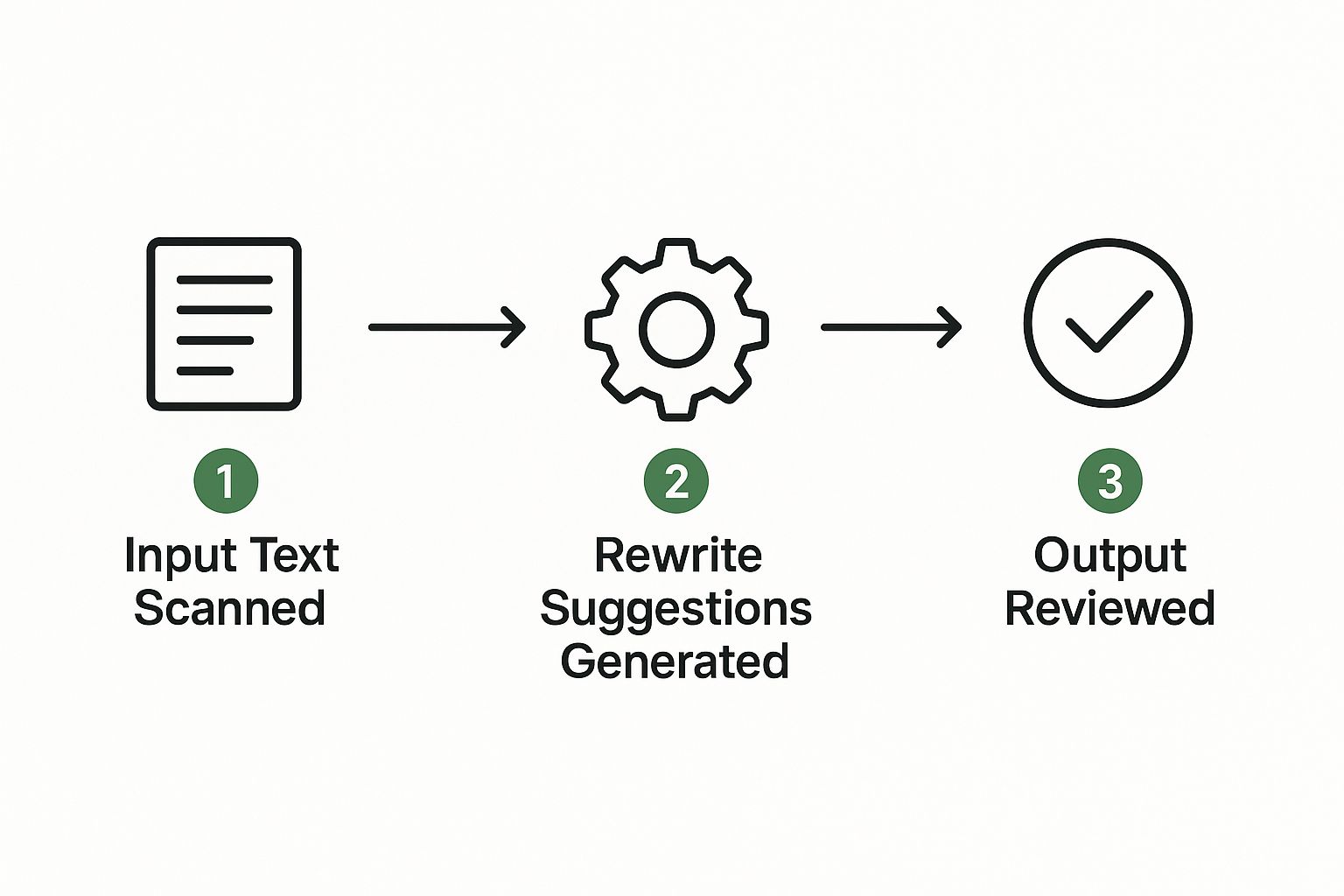
Using an AI Detector and Rewriter to Humanize Content
August 1, 2025
An ai detector and rewriter isn't just a nice-to-have anymore. For anyone creating content today, it's become a core part of the process. This two-step dance—first spotting the robotic parts of AI text, then polishing them with a human touch—is absolutely essential for making content that feels real and trustworthy.
Why Humanizing AI Content Is More Important Than Ever

Let's face it: as AI-generated text floods the internet, your readers are getting incredibly good at sniffing out content that feels cold and impersonal. Whether you're a marketer trying to connect, a student aiming for originality, or a creator building a brand, publishing text that lacks a genuine human voice is a huge risk. It can erode trust, damage your credibility, and ultimately, fail to connect with anyone.
The goal here isn't just about dodging penalties. If you look at Google's perspective on AI-generated content, the real focus is on quality and helpfulness, not how the text was made. This is exactly where the human touch becomes your secret weapon.
The Shift Toward Authenticity
Across the board, there's a huge push for authenticity. People are tired of generic, soulless content. They're actively seeking out unique perspectives, personal stories, and a clear point of view that they can relate to.
Here’s why taking the time to humanize your content is a game-changer:
- Builds a Real Connection: When you refine AI text, you swap out predictable, robotic phrasing for language that builds rapport and trust. It feels like a conversation, not a lecture.
- Boosts Search Performance: Quality and helpfulness are everything to search engines. Humanized content naturally provides the depth, experience, and nuance that they're designed to reward.
- Maintains Academic Integrity: For students, using AI as a starting point is fine, but the final submission has to be theirs. Refining the draft is how you ensure it reflects your own critical thinking and unique academic voice.
This growing demand for authentic content is powering a massive industry. The AI content detection market, valued at around $2 billion in 2025, is expected to skyrocket to an estimated $10 billion by 2033. That explosive growth tells you everything you need to know: there's a global demand for tools that help verify and elevate content quality.
We put together this guide to give you a practical framework for using an ai detector and rewriter like Natural Write. You'll learn exactly how to spot robotic text and, more importantly, how to transform it into compelling, human-sounding content that truly resonates with your audience.
How to Select the Right AI Detector and Rewriter

With a flood of tools on the market, choosing the right AI detector and rewriter can feel overwhelming. A lot of platforms make big promises, but their performance often falls short. Your goal is to find a tool that actually fits what you need—whether you're a marketer trying to protect a brand’s voice or a student trying to ensure academic integrity.
Forget the marketing hype for a second and focus on what really matters. I've tested my fair share of these platforms, and I’ve found that the best ones always deliver on three things: detection accuracy, rewriting quality, and overall ease of use. A mediocre tool might just swap a few synonyms, creating awkward phrases that still get flagged as AI. A great one, however, understands context and genuinely restructures sentences for a natural, human flow.
Evaluating Key Features
When you're comparing your options, you have to look beyond the flashy landing pages. The difference between a good tool and a great one is always in the details. Before you commit to any platform, I’d highly recommend running your own tests with the kind of content you work with every day.
Here are the non-negotiables to look for:
- Detection Accuracy: How well does it actually spot AI-generated text? Test it with content from ChatGPT, Claude, and others to see if it can consistently pick up on those robotic patterns.
- Rewriting Nuance: Does the rewriter just change words, or does it actually improve the clarity and tone? A top-tier tool like Natural Write helps you refine the text so it sounds authentically human, not just different.
- Integrated Workflow: Can you detect and rewrite in the same place? A seamless process saves a ton of time and frustration compared to jumping back and forth between separate tools.
The most important test is a practical one. Grab a paragraph you know was written by AI and see how the tool rewrites it. Does the new version keep the original meaning while sounding more natural and engaging? This hands-on check is the best way to find a reliable AI detector and rewriter you can trust.
A Practical Guide to Detecting AI-Generated Text
Using an AI detector and rewriter effectively is more of an art than a science. It's not just about chasing a high "human" score; it's about developing an eye for why the tool is flagging certain parts of your text. A good detector doesn't just give you a percentage—it shows you the specific passages that set off its alarms.
Think about it. A cookie-cutter blog intro packed with predictable sentence starters and vague claims? That’s almost always going to get flagged. But a paragraph with a unique voice, varied sentence lengths, and a bit of personality is far less likely to raise suspicion. Learning to spot these differences yourself is the first real step to making smart edits.
Interpreting the Results with a Critical Eye
Here’s the thing: even the best AI detectors make mistakes and can give you false positives. That’s why your own judgment is the most important tool you have. Don't just take the score as gospel.
Instead, zoom in on the highlighted text. Ask yourself: does this truly sound robotic, or is it just a simple, factual statement that any human would write?
The demand for these verification tools is exploding. The global AI content detection market is expected to jump from USD 1.79 billion in 2025 to a massive USD 6.96 billion by 2032. This growth is fueled by everyone from media outlets and universities to large corporations needing to verify content.
This diagram breaks down the basic workflow for turning AI text into something you can be proud of.

As you can see, it boils down to three core steps: scanning your original text, letting the tool generate rewrite suggestions, and then—most importantly—doing a final human review. This simple process gives you the power to confidently tweak and improve any piece of content.
The real skill isn't just spotting AI-generated text. It's understanding why it got flagged in the first place. That insight is what makes the rewriting stage so much more effective.
If you want to really get under the hood of how this all works, check out our guide on how do AI detectors work. It will give you a much better feel for what's happening behind the scenes, so you can interpret the results and spot those pesky false positives with more confidence.
Turning Robotic Text into Relatable Content

So, an AI detector has flagged your content. What now? This is where the real work begins, and it’s also where a good AI detector and rewriter like Natural Write becomes more than just a checker—it becomes a creative partner.
The goal isn't just to fool an algorithm by swapping a few words. It's about taking that robotic, predictable output and breathing some life into it. You want to transform it into content that actually connects with a human reader.
This means breaking up those monotonous sentence structures and tired phrases that AI models love. It's about injecting a consistent tone, adding your unique perspective, and weaving in the personal touches that make human writing so compelling.
A Practical Example: From AI-Generated to Genuinely Human
Let’s walk through a common scenario. You ask an AI to write a short blurb for a travel blog about Paris, and it gives you this:
- Before (AI-Generated): The city of Paris offers many attractions for tourists. Visitors can see the Eiffel Tower, which is a famous landmark. The Louvre Museum contains many famous artworks. Additionally, people can enjoy walking along the Seine River. The culinary scene is also notable.
It’s correct, but it's completely sterile. There's no emotion, no flair, no reason for a reader to care. Now, watch what happens when we focus on humanizing it.
- After (Humanized): Paris is a city that truly gets under your skin. Of course, you have to see the Eiffel Tower, but the real magic is feeling the city's pulse as you wander along the Seine. I always tell friends to get lost in the Louvre for an afternoon—you'll discover so much more than just the Mona Lisa. And don't even get me started on the food; every little bakery has a story to tell.
See the difference? The humanized version has a voice. It uses evocative language and even shares a personal opinion. It’s not just a list of facts anymore; it’s an invitation to feel something. This is what a quality rewriter helps you achieve.
Key Moves for an Effective Rewrite
Getting this kind of transformation right is a mix of art and science. You have to lean on the tool's suggestions while still applying your own judgment. If you want to go deeper, our guide on how to humanize AI text is packed with more actionable strategies.
But for now, here are a few core techniques I always come back to:
- Vary Your Sentences: Don't let every sentence follow the same structure. Mix short, punchy statements with longer, more descriptive ones. It creates a rhythm that’s much easier and more enjoyable to read.
- Inject Your Personality: This is your content. Add your own opinions, tell a quick story, or toss in a rhetorical question. Make it sound like it came from you, not a machine.
- Use Stronger Verbs: Hunt down weak or passive verbs and replace them with active, powerful ones. Instead of saying something is good, show why it's good. Strong verbs paint a much clearer picture.
When you pair these strategies with a capable AI detector and rewriter, you can turn bland AI drafts into polished content. The kind that not only avoids detection but actually persuades, engages, and connects with your audience.
Advanced Strategies for Truly Undetectable Content
Moving beyond a simple rewrite is where the real magic happens. To create content that's truly undetectable, you need to think less like an editor and more like an expert sharing genuine insight. It's not just about passing a scan; it's about crafting something that reads with an authority and nuance that AI just can't fake.
Start by weaving in the specific language of your niche. AI models are trained on the whole internet, so they often miss the subtle jargon or proprietary terms that signal you're an insider. Instead of saying "our innovative software," call it by its name—the "Quantum X1 processor," for instance. That small detail instantly adds a layer of credibility.
Weave in Unique Data and Stories
Next, you'll want to ground your content in reality. This is where you can really pull away from the AI pack. AI can find generic stats, but it can't share a specific number from your latest case study or tell a quick story about a client's success. This is your secret weapon for authenticity.
The market for these tools is exploding because readers crave that realness. In fact, the ai detector and rewriter market was valued at around USD 1.2 billion in 2024 and is expected to hit USD 4.5 billion by 2033. That growth proves how much people want content that feels human. You can dig into industry reports for more on these trends.
Finally, bring your writing to life by thinking like a storyteller.
- Use metaphors: Explain a complex idea by comparing it to something simple and familiar.
- Ask a question: Pull your reader in and make them part of the conversation.
- Change your rhythm: Mix short, punchy sentences with longer, more descriptive ones. It makes the text flow naturally, just like a real conversation.
Here's a pro tip: Read your final draft out loud. Seriously. Does it have a natural rhythm? Does it sound like something a real person would actually say? This final check helps you catch any lingering robotic stiffness that even a good AI detector and rewriter might overlook.
When you apply these advanced techniques, your content becomes more than just undetectable—it becomes more effective. For more hands-on advice, our detailed guide on how to make AI writing undetectable offers even more strategies to help you polish your work.
Burning Questions About AI Content Tools
Once you start working with an AI detector and rewriter, a few questions are bound to come up. It's smart to get these sorted out early so you can work confidently and ethically. Let's dig into some of the most common ones I hear.
Can These Tools Guarantee My Content Will Pass All AI Checks?
Honestly, no tool can offer a 100% guarantee, and you should be wary of any that claim they can. Think of it this way: AI detection models are a moving target, constantly being tweaked and updated. The real goal isn't just to "beat the scan."
A much better approach is to use a rewriter to bring genuine human qualities into the text. Your focus should be on adding your own insights, mixing up sentence structures, and injecting a distinct tone. When you do that, the content becomes far more valuable to your readers and, as a side effect, naturally harder for a machine to flag.
The best strategy has always been to create high-quality, authentic content. When you make that your priority, bypassing detection becomes a natural outcome of good writing, not the main objective.
Is It Ethical to Use an AI Rewriter for My Work?
The ethics here really come down to how you're using the tool and what your intent is. If you're using it to polish your own raw ideas, break through a stubborn case of writer's block, or rephrase a clunky sentence to make it clearer, most people would consider that a perfectly acceptable use of a writing assistant.
Where it gets tricky is when you take a lightly edited AI draft and pass it off as entirely your own original thought, especially in academic or professional settings where that's a big no-no. The key is to use the rewriter to enhance your own thinking, not to replace it.
How Will This Affect My SEO?
When you use them the right way, an AI detector and rewriter can actually give your SEO a nice little boost. By humanizing AI text, you're directly improving things that search engines love, like readability, user engagement, and how long people stick around on your page. These are all positive signals.
It helps you produce content that naturally aligns with Google’s E-E-A-T guidelines by adding the unique experience and expertise that AI on its own just can't replicate. If you're interested in keeping up with conversations about AI content tools, the AI Tools Brief Blog is a great resource with helpful articles.
Ready to stop sounding like a robot and start connecting with your readers? Give Natural Write a try and see what a difference a truly smart rewriter makes. You can instantly refine your AI drafts for clarity, tone, and authenticity with a single click. Head over to https://naturalwrite.com to get started for free.


